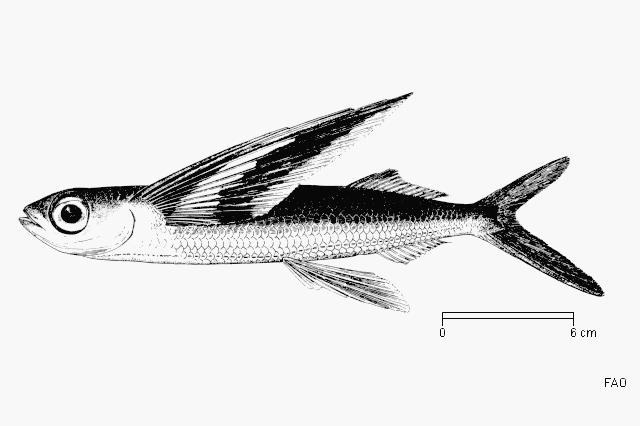Spotfin Flyingfish, Cheilopogon furcatus (Mitchill 1815)
Other Names: Flyingfish

Illustration of a Spotfin Flyingfish, Cheilopogon furcatus. Source: FAO / FishBase. License: CC By Attribution-NonCommercial
Summary:
A dark iridescent bluish-black flyingfish, becoming abruptly silvery-white below, with grey pectoral fins with a pale median band (almost reaching upper margin of fin) and a pale posterior margin. The Spotfin Flyingfish has a grey dorsal fin, a transparent anal fin (with black spots on both fins), pale pelvic fins, and a pale to dark grey caudal fin.
Cite this page as:
Bray, D.J. 2022, Cheilopogon furcatus in Fishes of Australia, accessed 04 Jul 2025, https://fishesofaustralia.net.au/home/species/3719
Spotfin Flyingfish, Cheilopogon furcatus (Mitchill 1815)
More Info
|
Distribution |
West of Geralton, Western Australia, to Ashmore Reef in the Timor Sea, and the northern Great Barrier Reef, Queensland, and reefs in the Coral Sea, to central New South Wales; also the Lord Howe Province in the Tasman Sea. Elsewhere the species is circumglobal in tropical and subtropical waters. Inhabits surface waters in the open ocean. This is a true oceanic species that does not occur in inshore waters during any period of life. |
|
Features |
Dorsal fin 12-14; Anal fin 8-11; Pectoral fin 14-17; Vertebrae 43-46; Gill rakers on first arch 18-25. Predorsal scales 25-34; Scales in transverse row 7-9. Body elongate, nearly rectangular in cross-section, almost flat ventrally. Head shorter than distance between dorsal-fin origin and origin of upper caudal-fin lobe. Upper jaw not protrusible; lower jaw slightly projecting; palatine teeth absent. Dorsal fin low; anal fin originating under fifth to seventh dorsal-fin ray; pectoral fins 1.3 to 1.5 in standard length, first ray unbranched; pelvic fins 2.7 to 3.3 times in standard length, inserted nearer to posterior margin of opercle than origin of caudal-fin base. Juveniles with a pair of rather long (up to 50% SL) chin barbels, without lateral flaps. |
|
Size |
|
|
Colour |
Body dark above, pale below. Dorsal and caudal fins greyish; anal fin transparent; pectoral fins almost black to grey (deep blue in life) with unpigmented oblique cross-band reaching or nearly reaching upper margin of the fin and very broad unpigmented margin along rear edge of the fin. Juveniles 50 to 100 mm standard length with 6 transverse vertical bars on body; dorsal and anal fins with black spots; pectoral fins with dark lower part and 2 oblique dark bands; pelvic fins also with dark spots and bands. |
|
Feeding |
Feed mainly on small fishes as well as amphipods and siphonophores. |
|
Biology |
Females lay demersal eggs on drifting algae and other floating objects; eggs 1.5-1.7 mm in diameter, with two bunches of filaments on opposite poles, one consisting of 10-12 tiny threads, the other with 18-20 long filaments, about twice the egg diameter in length. |
|
Remarks |
Avoids predators by leaping out of the water and gliding above the surface of the water for considerable distances. |
|
Etymology |
The specific name is from the Latin furcatus (= forked), possibly in reference to the two long chin barbels of this species in juveniles, described by Mitchill as "Two cirrhi or tough appendages, half an inch long, hanging from the chin." which may appear as a single forked barbel. |
|
Species Citation |
Exocoetus furcatus Mitchill 1815, Transactions of the Literary & Philosophical Society of New York 1(5): 449, pl. 5 (fig. 2). Type locality: off New York, USA. |
|
Author |
Bray, D.J. 2022 |
|
Resources |
Spotfin Flyingfish, Cheilopogon furcatus (Mitchill 1815)
References
Choat, J.H., van Herwerden, L., Robbins, W.D., Hobbs, J.P. & Ayling, A.M. 2006. A report on the ecological surveys undertaken at Middleton and Elizabeth Reefs, February 2006. Report by James Cook University to the Department of the Environment and Heritage. 65 pp.
Collette, B., Singh-Renton, S., Robertson, R., Marechal, J., Aiken, K.A., Dooley, J., Oxenford, H., Pina Amargos, F. & Kishore, R. 2015. Cheilopogon furcatus. The IUCN Red List of Threatened Species 2015: e.T190391A15603105. https://dx.doi.org/10.2305/IUCN.UK.2015-4.RLTS.T190391A15603105.en. Downloaded on 07 July 2021.
Gomon, M.F. 2008. Family Exocoetidae. pp. 402-405 in Gomon, M.F., Bray, D.J. & Kuiter, R.H. (eds). Fishes of Australia's Southern Coast. Sydney : Reed New Holland 928 pp.
Hutchins, J.B. & Swainston, R. 1986. Sea Fishes of Southern Australia. Complete field guide for anglers and divers. Perth : Swainston Publishing 180 pp.
Kovalevskaya, N.V. 1980. Reproduction, development and distribution patterns of larvae and juveniles of the oceanic flying fishes in the Pacific and Indian Oceans. Trudy Instituta Okeanologii. Akademiya Nauk SSSR. Moskva 97: 212-275 figs 1-26 [in Russian]
Mitchill, S.L. 1815. The fishes of New York, described and arranged. Transactions of the Literary & Philosophical Society of New York 1(5): 355-492 6 pls See ref at BHL
Parin, N.V. 1996. On the species composition of the flying fish species (Exocoetidae) in the west-central part of the tropical Pacific Ocean. Journal of Ichthyology 36(5): 357–364
Parin, N.V. 1999. Family Exocoetidae. pp. 2162-2179 in Carpenter, K.E. & Niem, T.H. (eds). The Living Marine Resources of the Western Central Pacific. FAO Species Identification Guide for Fisheries Purposes. Rome : FAO Vol. 4 pp. 2069-2790.
Parin, N.V. 2009. Cheilopogon olgae (Exocoetidae) - a new species of flying fish from the waters of Western Australia. Journal of Ichthyology 49(3): 271-275
Parin, N.V. & Belyanina, T.N. 1998. Age and geographic variability and distribution of the flying fish Cheilopogon furcatus (Exocoetidae, Beloniformes), with a description of two new subspecies. Journal of Ichthyology 38(8): 557-573
Stewart, A.L. & Struthers, C.D. 2015. Family Exocoetidae. pp. 954-964 in Roberts, C.D., Stewart, A.L. & Struthers, C.D. The Fishes of New Zealand. Wellington : Te Papa Press Vol. 3 pp. 577-1152.


